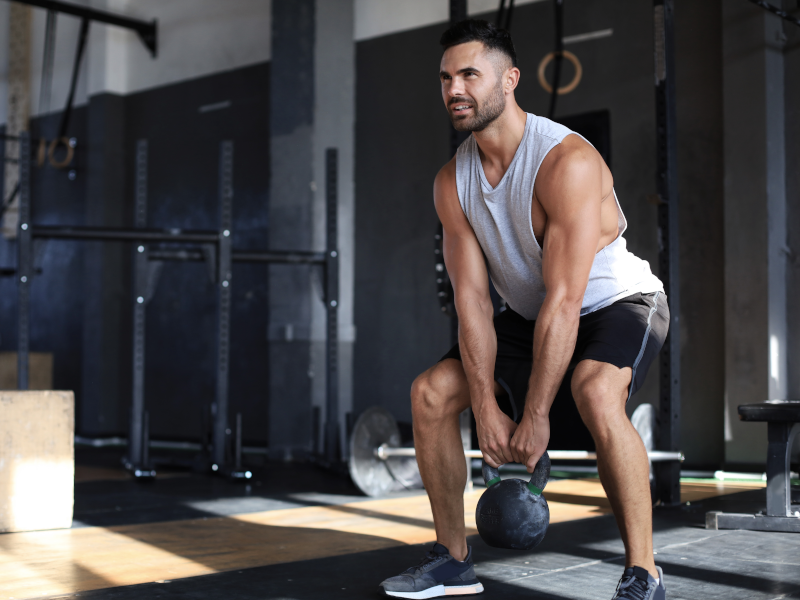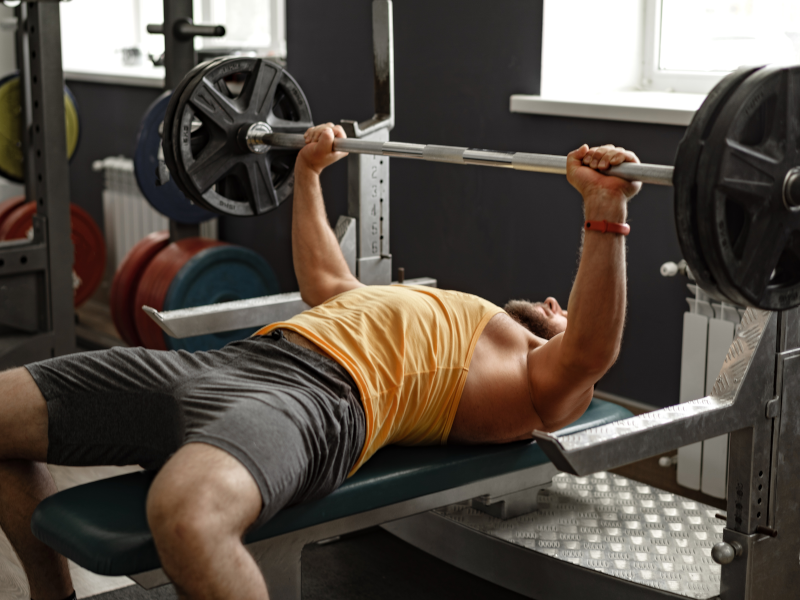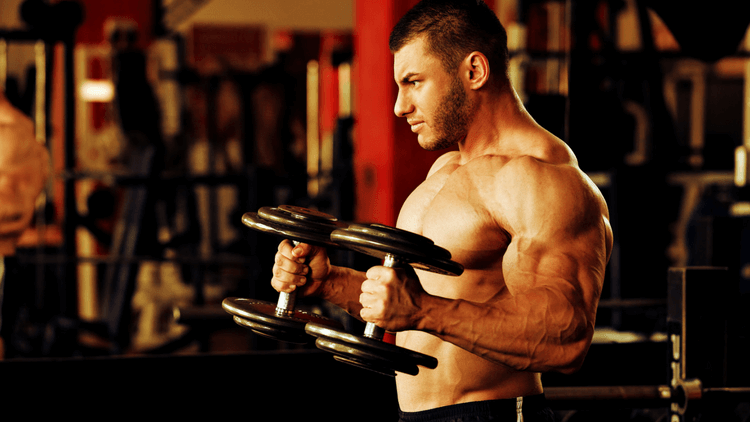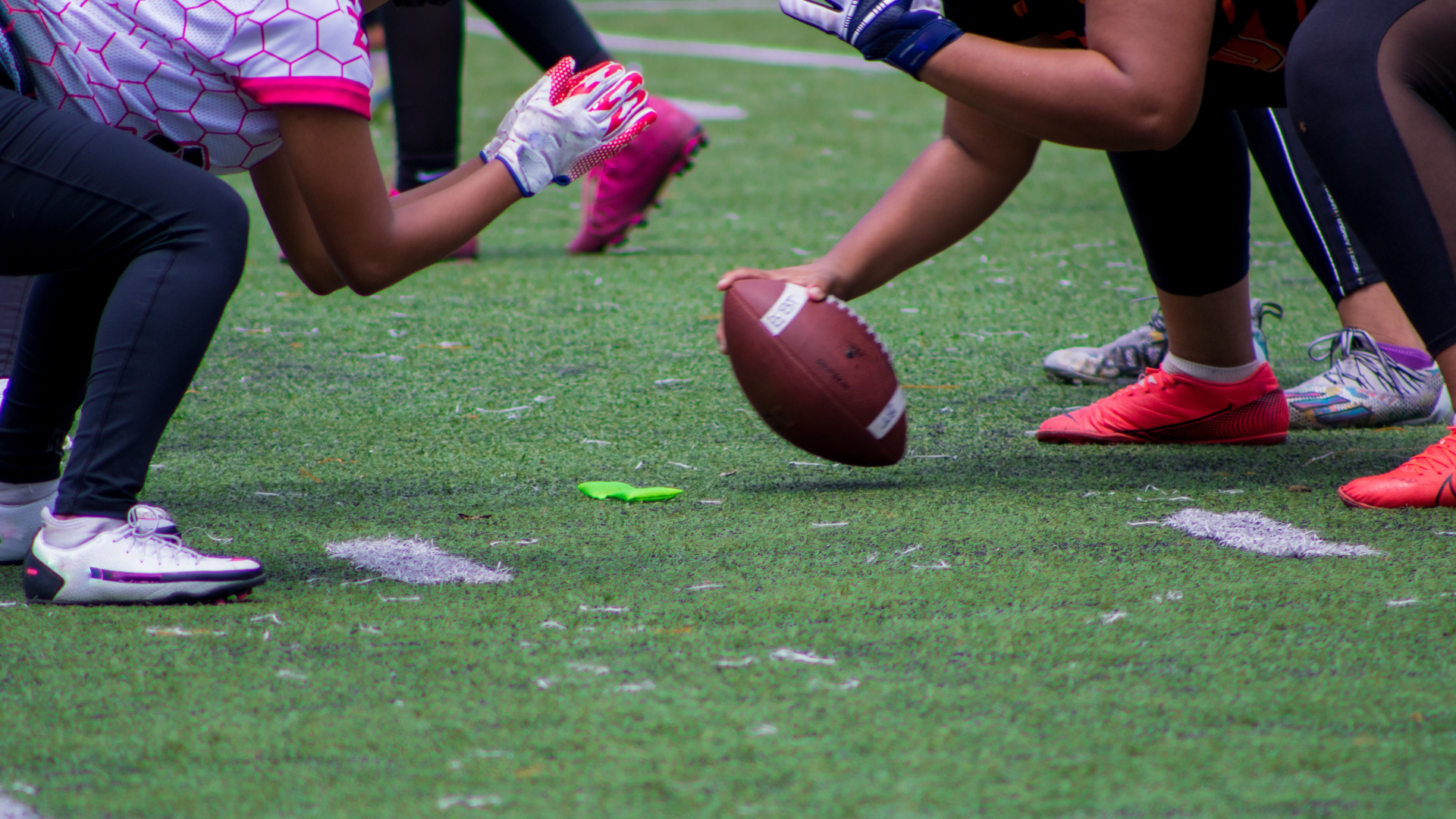Hack Beast Mode |
We recently took a deep dive into calories, macros, and all things food-related for building muscle mass.
And whilst nutrition is an absolutely crucial part of bulking up and getting in great shape, it will only take you so far if you’re not training correctly. It doesn’t matter if you hit your macros perfectly or consume the healthiest diet known to man, without a strong gym routine to go alongside it, your progress will stall.
A strong meal plan and workout plan should go hand in hand: they need to complement each other.
If you’re the adventurous and curious type, you’ll probably be interested in setting up your workout plan, but this takes a bit of experimentation and knowledge.
But we’re here to help you do just that.
We’ll cover sets, reps, timing, exercises, splits, rest, recovery, and everything else you need to construct your personal muscle-building workout routine.
Workout Splits
Depending on your preferences, goals, and availability, your training can revolve around various splits.
By splits, we just mean how you break your week down into sessions of exercise.
Attempting a full-body workout every day is not the most beneficial way to approach your gym sessions. Instead, each workout should focus on specific body parts or types of exercise.
Not only does this allow you to make the most of each workout by lifting a higher volume for each body part, but it also ensures that your muscles can recover properly before they are next targeted.
How you split your workouts down is entirely up to you and will likely depend on various factors, such as how often you can train, how long your sessions will be, what equipment you have to hand in, and what your ultimate goal is.
How many days per week you intend to train will probably have the biggest influence, though – as most workout routines are based around three-, four-, or five-day splits.
Training two days or less each week is unlikely to be enough to successfully accumulate mass (although it is certainly better than nothing), whereas training six or seven days a week doesn’t allow for as much recovery time, reduces the intensity you can lift with as time goes by, and is more likely to lead to injuries. Sticking to the sweet spot of three to five sessions a week is the smart move.
Let’s take a look at some example workouts you could use as a starting point for different splits.
Three-day splits

If you can only commit to working out three days a week, then that’s fine – there are no rules saying you have to be in the gym more than that. You’ll just need to ensure you make the best possible use of the time available during each session.
One of the most efficient ways to do so is by having a push day, a pull day, and a leg day.
Your push movements are largely focused on your chest, triceps, and shoulders – as these muscles will push weights away from your body. Whereas pull-focused lifts mainly concern your back, biceps, and traps – which you use to pull weights toward your body.
Leg workouts will focus on lower bodywork, often involving compound movements that can pump up your testosterone levels and will require a lot of energy to get those big leg and glute muscles firing.
Splitting your three workouts in this way will allow you to really work each muscle group with a full range of movements but with plenty of recovery time before you hit those body parts again. You could also repeat these workouts if you really wanted to hit the gym six times a week. (Although this isn’t something we’d necessarily recommend or is even required to build muscle.)
A sample routine following this push-pull-legs split could look like this:
Push Day:
- Barbell bench press
- Incline dumbbell press
- Dumbbell chest flyes
- Overhead press or Arnold press
- Bodyweight dips
- Skullcrushers or tricep extensions
- Tricep pushdowns
Pull Day:
- Deadlifts
- Barbell rows or dumbbell rows
- Pull-ups or chin-ups
- Lat pulldowns
- Barbell curls or dumbbell curls
- Reverse dumbbell flyes
- Hammer curls
Leg Day:
- Squats
- Lunges
- Leg press
- Leg extensions
- Calf raises
- Leg curls
Something else to consider on your three-day split (or any split, really), is some core work. While your core already plays a role in most movements you’ll do in the gym (particularly compound movements), you may wish to add in some ab-based exercises at the end of your leg-day workout, or as finishers to each gym session.
You’ll notice that sets and rep count weren’t added to the workout examples above, and that’s because we’ll cover some variations in a bit more depth below.
Another option for three-day splits is to focus on full-body workouts that involve mostly compound movements. The trick is to mix up the type of lifts you do for different workouts.
For example, build a workout around squats, bench presses, and pull-ups for your first workout, then switch to a deadlift, dips, and barbell row focus for the next one. This keeps your workouts fresh, gives all muscle groups an outing, and doesn’t overtax your body on any specific movement.
Four-day splits and five-day splits

There are countless ways to split your sessions when you are able to work out four or five days per week.
This is great in that you are able to spend more time in the gym and you can really mix it up and focus on the types of workout that you want to create. But with so much choice, there can also come confusion.
So when first designing your four- or five-day splits, it’s best to keep it simple. Start by learning which exercises you like, which you don’t like, and what your body is capable of. Then you can build upon this base to iron out any weaknesses or underperforming areas and experiment with different workouts to see what will benefit your body type more. You’ll also be able to shake it up pretty easily if you start to plateau.
There is so much variation, so there isn’t space here to run through full sample workouts. It is far better for us to run through some popular splits that you can then flesh out with exercises of your choice. Here are some of our favorites:
Upper/lower push/pull (four days):
- Day 1: Upper body – push focused
- Day 2: Lower body – push focused
- Day 3: Upper body – pull focused
- Day 4: Lower body – pull focused
This one is quite self-explanatory, you’ll do two upper-body workouts and two lower-body workouts, with a push day and a pull day for each.
Upper/lower-strength/hypertrophy (four days):
- Day 1: Upper body – strength
- Day 2: Lower body – strength
- Day 3: Upper body – hypertrophy
- Day 4: Lower body – hypertrophy
A similar split to the previous suggestion, but instead of focusing on push and pull days, your workouts are split between high-weight/low-volume strength training and lower-weight/high-volume workouts to hypertrophy (i.e., improving the size of your muscles, not necessarily strength, by working them to exhaustion with increased reps).
Paired muscle groups (four days):
- Day 1: Chest and triceps
- Day 2: Back and biceps
- Day 3: Legs and abs
- Day 4: Shoulders and traps
By pairing up muscle groups in this way, your workouts will look somewhat similar to the push/pull/legs workout we saw for the three-day split. Chest and tricep exercises are mostly push-based, whereas back and biceps mainly utilize pulling motions. Your legs and abs day will likely stay the same as in the three-day example, then you are able to give your shoulders and traps a separate workout to focus on growth in your upper body, leading to a larger frame for the muscle to be packed onto.
Single body parts (five days):
- Day 1: Chest
- Day 2: Back
- Day 3: Shoulders
- Day 4: Arms
- Day 5: Legs
Five full weight-based workouts a week are not for the faint-hearted. This is not a split that we recommend for beginners, as your muscles will not yet be used to such stress and intensity – this is something that you will have to work up to if you want to safely and efficiently lift this many times per week.
These are all great starting points, but there are almost limitless variations and alternatives that you can experiment with once you’ve laid a solid foundation.
We have plenty of workout plans you can follow on our blog and our YouTube channel. So make sure you check them out if you’re ever feeling stuck for ideas, struggling to make the gains with your current plan, or just need some inspiration to freshen things up a bit.
Remember: muscle growth happens when you challenge yourself – if your body becomes too used to what you’re doing, it will be hard to make a breakthrough and get those gains.
Reps and sets

Once you’ve decided on a workout split that suits your goals and your lifestyle, you’ll need to consider your reps and your sets – this is the standard way in which people measure and record their progress in the gym.
Reps = repetitions (e.g., one completed bicep curl is one rep)
Sets = a series of reps performed in one block or chunk (e.g. a set of 10 squats)
Here are several aspects of reps and sets that you can modify to improve your results.
Volume
How many sets you do, and how many reps you perform in each of those sets, is one of the easiest changes to make that will provide different slants to your workouts.
Your overall lifting volume (i.e., sets x reps x weight) will differ depending on what your goal is when it comes to lifting.
-
Strength: If you’re training for strength, using heavy weights for a lower amount of reps and sets is ideal. 3-6 sets of 3-6 reps is your window here, with 5x5 being a commonly-used strategy for each exercise.
-
Power: Similar to strength training, you’ll be lifting heavy for a small number of reps per set, but the weight will be closer to your 1RM (one-rep max – the maximum amount you can lift with good form for just one rep). Try 3-5 sets of 2-6 reps. Athletes and professional weightlifters use these sorts of ranges to build explosive power using huge compound movements. This very advanced strategy should be slowly and safely worked up to over time.
-
Hypertrophy (i.e. size): To accumulate mass and increase your muscle size, you’ll need to use weights that you can lift for around 3-5 sets of 8-12 reps, but no more than that. Your final couple of reps in your last set should feel very tough like you couldn’t possibly do another one – we call this training to failure. Fatiguing your muscles like this puts the requisite amount of metabolic stress on them to tear so they can then be repaired bigger and stronger. Lifting moderately heavy weights for 3 sets of 10 is a good starting point for each exercise. If you find you aren’t reaching failure (or near failure) at the end of the third set, you need to increase the weight, or if you can’t manage to perform the 3x10 or 3x12 that you’ve opted for without compromising your form, you’ll need to drop down to a slightly lower weight.
- Endurance: This is not really a strategy that somebody looking to build muscle mass should choose. Endurance training involves lifting lighter weights for much longer sets – typically 2-3 sets of anywhere from 12-30 reps. This form of weight training is geared more towards runners, cyclists, swimmers, etc. – athletes who need their muscles to perform over a prolonged period of time.
Rest periods

Another key training component is rest time. Your rest intervals between sets will differ depending on your lifting type. As a general guideline:
- Endurance = around 30 seconds rest between sets
- Hypertrophy = 30-90 seconds
- Strength = 1-5 minutes
- Power = 2-5 minutes
As you have probably noticed, you’ll need to take longer rest periods when you lift heavier weights than you would with lighter weights. Getting your rest times right is important – too short and you risk injury or fatiguing your muscles too quickly, too long, and your muscles can start to cool down and lose tension.
Tempo
Something else to consider when lifting weights is your tempo.
There are three key phases to each rep:
-
Eccentric contraction: Also known as the “negative” or “lowering” phase, this involves lengthening the head of the muscle as resistance increases relative to the muscular force used (e.g. lowering the bar to your chest during a bench press or lowering the dumbbell(s) down during a bicep curl).
-
Isometric hold: The transition or mid-point of a lift (e.g. the slight pause as the barbell sits on your chest during a bench press or the dumbbell(s) pause near your shoulders at the top of a bicep curl).
- Concentric contraction: Also referred to as the “positive” or “lifting” phase, as the muscle shortens and its tension increases to counter the resistance of a weight (e.g., pushing the bar up and away from your chest during a bench press or raising the dumbbell(s) towards your shoulder during a bicep curl).
Each phase has its own number used to reflect the time it takes to complete that part of a lift. For example, a rep tempo of 3-1-3 involves taking three seconds to lower the weight, pausing for one second at the midpoint, then taking three seconds to lift the weight.
You may also see a fourth stage included on some tempos, but this is just the slight pause after the completion of a rep (and is usually only written as a 0 or a 1).
There are multiple ways to approach rep tempo; common ones include:
- 1-3-1
- 2-2-2
- 3-1-1
- 4-1-4
- 4-2-1
- 5-0-1
It’s worth pointing out here that some movements start eccentrically, whereas others begin concentrically. Therefore, it’s important to note your starting position so that you can follow the rep tempo correctly. For example, when starting a pull-up from a dead hang, your first movement will be the concentric pull of your body towards the bar, which is the third number in the sequences above. So just ensure you know these discrepancies before you begin a set.
Keep in mind also that the negative aspect of a rep is just as important as the positive part and that lifting and lowering at a slower rate will tax your muscles in a different way than purely lifting up and down at a fast or steady pace, as will pausing for longer at the top of the rep. Feel free to experiment with tempos and your overall time under tension to see what best benefits your workout routine – compound movements require different timings to more isolated exercises, for example.
No matter how many sets and reps you perform and at what tempo, the most important thing to take into account is your form.
Controlling your tempo will ensure that you perform each movement with the correct form and gives you an underlying structure you can easily stick to during subsequent workouts.
Whether you’re lifting heavy weights for shorter bursts, lighter weights for extended periods, or anything in between, it is crucial that you are able to lift that weight with good form to get the most effective results and avoid injuries to your muscles.
Exercises

Each muscle group or body part has numerous different lifts and movements. So finding ones that you are able to do safely (e.g., don’t try lifting huge barbells over your head to perform squats – make sure you use a squat rack or Smith machine) and that you enjoy should be relatively straightforward.
We’ve covered some of the core exercises for various muscles above, but you can find more examples and inspiration over on our website and social media channels to keep it fresh and mix things up if they ever get stale.
Some other things to bear in mind regarding the routine you put together:
-
Track your workouts: It’s only by marking down what you actually do in the gym (either written out or recorded digitally) that you’ll be able to improve. Don’t underestimate how easy it can be to forget what you lifted in a previous session if you don’t get it down on paper or in an app. Hold yourself accountable with this.
-
Progressive overload: The main reason to track your progress is that it allows you to increase the difficulty of your workouts over time, which leads to muscle growth. This is called progressive overload, and you can achieve this in several ways – you could vary the reps, sets, weights, rest times, tempo, or overall length of your workouts.
-
Cardio: Although you’ll mainly be focusing on lifting weights in your quest to build muscle, you shouldn’t forget about cardio. As long as your calories and macros account for it, there’s no reason why cardiovascular activity would hinder your muscle-building progress. For example, low-intensity steady-state cardio (LISS), like slow and extended sessions of walking, jogging, or cycling, can be used as active recovery to keep you trim without placing high demands on your muscles. Alternatively, high-intensity interval training (HIIT) can keep you burning calories for several hours after your workouts, which helps you burn fat and build muscle.
- Bodyweight training: Whilst you’re unlikely to see such impressive results as you would from lifting heavy weights, training using just your bodyweight can be a decent alternative for keeping you active on rest days or when you are unable to make it to the gym (if you’re traveling, for example). There are plenty of muscle-building exercises you can do using nothing but the resistance of your own body or with minimal equipment (e.g. press-ups, squats, lunges, pull-ups). On days when you can’t do a full weight-based workout, your body is there to step in and take up the slack.
Recovery
Just as important as the workouts that you put your body through is the recovery that you allow your muscles to receive.
The reason why proper rest is so vital, and why you schedule rest days throughout the week, is that the growth of your muscles happens on these days.
We’ve discussed hypertrophy and the tearing of muscle tissue so it can grow back bigger and stronger than it was before; well, this is when that protein synthesis can take effect. Cells called fibroblasts will repair your muscle tissue, plus your glycogen stores are able to be fully restored to build your energy levels back up before you next hit the gym.
This is exactly why six- and seven-day splits aren’t necessarily beneficial for muscle growth. If your muscles are constantly taxed but never given a chance to recover, then you aren’t going to experience optimal muscle growth. But you are likely to suffer injury or burnout from overtraining.
When you take your rest days will usually depend on your schedule, but your body will also let you know when you need them. If your energy starts to dip, your muscles feel sore, or your performance in the gym feels below par, then you are likely due a rest.

If you are working out between three and five days a week, you’ll never really need to go more than three days without a rest day, giving your body adequate time to recover from all the heavy lifting. If you find that on rest days, you feel you could hit the gym again, then your body may well be ready for you to add in an extra workout (e.g., change from a three-day to a four-day split), or you can increase the intensity of your current workouts.
While we call these recovery periods “rest days”, this doesn’t mean you should do no activity. On the contrary, you should remain active on non-gym days. Low-impact cardio is a great way to keep you moving and burning calories without overstressing your recovering muscles. Long walks or a gentle jog are easy ways to achieve this, as are light swimming or cycling sessions.
An alternative way to spend your rest days is doing some yoga or pilates. Not only do these activities get your blood flowing, they also provide an opportunity to stretch out any tightness in your body, improve your flexibility, and relax your mind and your muscles.
Likewise, stretching your muscles out before and after each workout will have positive effects on your body and help you avoid DOMS (delayed onset muscle soreness) and injuries.
Pre-workout stretches will warm up your muscles so they feel nice and loose, leading to more flexibility and range of motion when you lift. Then some post-workout cooldown stretches can increase your blood flow and aid recovery.
On your rest days, your body will generally require fewer calories to function, as you’re not exerting as much energy, but you don’t necessarily need to slash the amount of food you eat. Your protein intake is still vital, as it is required to repair your muscles while they recover from your previous workouts.
Drinking plenty of water is as important as ever – you should always stay hydrated, no matter what your activity levels are on any given day.
One final element of recovery that shouldn’t be underestimated is sleep. The obvious thing to mention here is that sleep is required to reduce fatigue and ensure you’re energized for the coming day, but there is more to it than just that.
Getting a full night’s sleep (between seven and nine hours is recommended for most people) with minimal interruptions is vital for muscle building. While you sleep, your body is busy producing the hormones required for repairing and growing your muscles. The release of human growth hormone (HGH) leads to muscle tissue being repaired and new muscle fibers being produced. So when you miss out on sleep, you miss out on muscle growth.
On those occasions when you have a night of poor quality sleep, or just not enough (which happens to all of us from time to time), then taking a brief nap during the day can stimulate the production of HGH that you may have missed out on somewhat the night before – as long as your nap takes you into a deep state of rest. 20-30 minutes can do the trick, but if you are feeling really sleep deprived then increasing your nap time to 60-90 minutes may be required.
Just make sure you don’t regularly miss out on good quality sleep at night and rely on napping as a crutch or get-out clause too often. The effects of sleep deprivation can quickly snowball from feeling stressed and exhausted into further health and fitness problems. If you have persistent trouble sleeping then you should speak to your doctor, for the benefit of your overall health as well as your ability to build muscle and stay in shape.
Supplementation

The final piece of your workout puzzle is what supplements you should use to get the most out of your hard work.
Whilst supplements aren’t strictly necessary, adding the right ones into your daily and weekly routines can certainly enhance your results further. We find the following types of supplements to be particularly beneficial.
- Protein powders: Incredibly useful for helping you hit your daily protein targets. Regular protein shakes (just add a scoop or two of your preferred powder to water or milk) are super easy additions to your meal plan that can aid protein synthesis for muscle growth. Available in multiple forms (such as whey, pea, and soy protein), there are also loads of flavors available to choose from, which you can use to add extra taste to smoothies and use as ingredients when baking or for making protein treats or snacks.
-
Creatine: A popular muscle-building choice, creatine provides your muscles with energy and extra strength for powering through a workout, squeezing out additional reps, and enhancing the post-workout recovery process.
-
Branched-chain amino acids: BCAAs are three essential amino acids (leucine, isoleucine, and valine) that your body cannot produce on its own, so they need to be consumed via diet or supplementation to help make protein. They are typically taken shortly before or after a workout for extra energy, reducing muscle soreness, enhance muscle growth, and support recovery.
-
Testosterone boosters: Low testosterone levels can severely hinder your ability to build muscle. So keeping your T-levels up at a safe but effective level can make a big difference to your results. The key ingredients for achieving this include zinc and magnesium (sometimes paired together as ZMA), D-aspartic acid (DAA), fenugreek, and Urtica dioica (AKA nettle leaf extract).
- Legal steroid alternatives: First of all, actual steroids are dangerous and illegal – so you should stay well clear of them. However, there are some safe and legal supplements out there that provide similar benefits but without any element of danger or harm to your body. Natural and safe ingredients used in steroid alternatives negate the need for prescriptions, needles, or putting your life in danger. Check out our current range of stacks and SARMs available here if you’re looking to really upgrade your gym game.
There are plenty of other supplements available for solving various health and fitness issues, but the ones listed above are the best places to start, in our opinion, to effectively build muscle mass and for aiding muscle recovery.
Putting it all together
So, now that we’ve looked at calories, macros, meal plans, workout plans, recovery, and supplements, we can look at bringing it all together so that you can finally put your personal muscle-building plan into action.
In our next article, we’ll recap what we’ve learned so far, and provide you with everything you need to put it into practice and start packing on muscle, staying motivated, and ultimately reaching your fitness goals.
Over 299,434 purchases
Over 509,389 bottles sold
Over 30,563,340 pills taken








